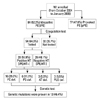1. Libby Peter, Bonow Robert O., Mann Douglas L., Zipes Douglas P.. Braunwald's Heart Disease: A Textbook of Cardiovascular Medicine. 2008. 8th ed. Philadelphia, PA: Elsevier Inc.;1863.
2. Tapson VF. Acute pulmonary embolism. N Engl J Med. 2008. 358:1037–1052.

3. Cushman M, Tsai AW, White RH, Heckbert SR, Rosamond WD, Enright P, et al. Deep vein thrombosis and pulmonary embolism in two cohorts: the longitudinal investigation of thromboembolism etiology. Am J Med. 2004. 117:19–25.

4. Couturaud F, Leroyer C, Julian JA, Kahn SR, Ginsberg JS, Wells PS, et al. Factors that predict risk of thrombosis in relatives of patients with unprovoked venous thromboembolism. Chest. 2009. 136:1537–1545.

5. Brouwer JL, Lijfering WM, Ten Kate MK, Kluin-Nelemans HC, Veeger NJ, van der Meer J. High long-term absolute risk of recurrent venous thromboembolism in patients with hereditary deficiencies of protein S, protein C or antithrombin. Thromb Haemost. 2009. 101:93–99.

6. Ridker PM, Miletich JP, Hennekens CH, Buring JE. Ethnic distribution of factor V Leiden in 4047 men and women. Implications for venous thromboembolism screening. JAMA. 1997. 277:1305–1307.

7. Simkova M, Batorova A, Dostalova K, Pozgayova S, Simko F, Kovacs L. Factor V Leiden in patients with venous thrombosis in Slovak population. Gen Physiol Biophys. 2004. 23:435–442.
8. Miyata T, Sato Y, Ishikawa J, Okada H, Takeshita S, Sakata T, et al. Prevalence of genetic mutations in protein S, protein C and antithrombin genes in Japanese patients with deep vein thrombosis. Thromb Res. 2009. 124:14–18.

9. Shen MC, Lin JS, Tsay W. Protein C and protein S deficiencies are the most important risk factors associated with thrombosis in Chinese venous thrombophilic patients in Taiwan. Thromb Res. 2000. 99:447–452.

10. Angchaisuksiri P, Atichartakarn V, Aryurachai K, Archararit N, Rachakom B, Atamasirikul K, et al. Risk factors of venous thromboembolism in thai patients. Int J Hematol. 2007. 86:397–402.

11. Altinisik J, Ates O, Ulutin T, Cengiz M, Buyru N. Factor V Leiden, prothrombin G20210A, and protein C mutation frequency in Turkish venous thrombosis patients. Clin Appl Thromb Hemost. 2008. 14:415–420.

12. Lijfering WM, Brouwer JL, Veeger NJ, Bank I, Coppens M, Middeldorp S, et al. Selective testing for thrombophilia in patients with first venous thrombosis: results from a retrospective family cohort study on absolute thrombotic risk for currently known thrombophilic defects in 2479 relatives. Blood. 2009. 113:5314–5322.

13. Lim W. Antiphospholipid antibody syndrome. Hematology Am Soc Hematol Educ Program. 2009. 233–239.

14. Choung HS, Kim HJ, Gwak GY, Kim SH, Kim DK. Inherited protein S deficiency as a result of a large duplication mutation of the PROS1 gene detected by multiplex ligation-dependent probe amplification. J Thromb Haemost. 2008. 6:1430–1432.

15. Suehisa E, Nomura T, Kawasaki T, Kanakura Y. Frequency of natural coagulation inhibitor (antithrombin III, protein C and protein S) deficiencies in Japanese patients with spontaneous deep vein thrombosis. Blood Coagul Fibrinolysis. 2001. 12:95–99.

16. Chen TY, Su WC, Tsao CJ. Incidence of thrombophilia detected in southern Taiwanese patients with venous thrombosis. Ann Hematol. 2003. 82:114–117.

17. Caprini JA, Goldshteyn S, Glase CJ, Hathaway K. Thrombophilia testing in patients with venous thrombosis. Eur J Vasc Endovasc Surg. 2005. 30:550–555.

18. Swiatkiewicz A, Jurkowski P, Kotschy M, Ciecierski M, Jawień A. Level of antithrombin III, protein C, protein S and other selected parameters of coagulation and fibrinolysis in the blood of the patients with recurrent deep venous thrombosis. Med Sci Monit. 2002. 8:CR263–CR268.
19. White RH. The epidemiology of venous thromboembolism. Circulation. 2003. 107:23 Suppl 1. I4–I8.

20. Baglin T, Luddington R, Brown K, Baglin C. High risk of recurrent venous thromboembolism in men. J Thromb Haemost. 2004. 2:2152–2155.

21. Kyrle PA, Minar E, Bialonczyk C, Hirschl M, Weltermann A, Eichinger S. The risk of recurrent venous thromboembolism in men and women. N Engl J Med. 2004. 350:2558–2563.

22. McRae S, Tran H, Schulman S, Ginsberg J, Kearon C. Effect of patient's sex on risk of recurrent venous thromboembolism: a meta-analysis. Lancet. 2006. 368:371–378.

23. Margaglione M, Brancaccio V, De Lucia D, Martinelli I, Ciampa A, Grandone E, et al. Inherited thrombophilic risk factors and venous thromboembolism: distinct role in peripheral deep venous thrombosis and pulmonary embolism. Chest. 2000. 118:1405–1411.

24. Christiansen SC, Cannegieter SC, Koster T, Vandenbroucke JP, Rosendaal FR. Thrombophilia, clinical factors, and recurrent venous thrombotic events. JAMA. 2005. 293:2352–2361.

25. Kim HJ, Kim DK, Koh KC, Kim JY, Kim SH. Severe protein C deficiency from compound heterozygous mutations in the PROC gene in two Korean adult patients. Thromb Res. 2008. 123:412–417.

26. Pintao MC, Garcia AA, Borgel D, Alhenc-Gelas M, Spek CA, de Visser MC, et al. Gross deletions/duplications in PROS1 are relatively common in point mutation-negative hereditary protein S deficiency. Hum Genet. 2009. 126:449–456.

27. Yoo JH, Kim HJ, Maeng HY, Kim YA, Sun YK, Song JW, et al. Hereditary protein S deficiency from a novel large deletion mutation of the PROS1 gene detected by multiplex ligation-dependent probe amplification (MLPA). Thromb Res. 2009. 123:793–795.

28. Song KS, Lee SM, Choi JR. Detection of an Ala601Thr mutation of plasminogen gene in 3 out of 36 Korean patients with deep vein thrombosis. J Korean Med Sci. 2003. 18:167–170.










 PDF
PDF ePub
ePub Citation
Citation Print
Print



 XML Download
XML Download